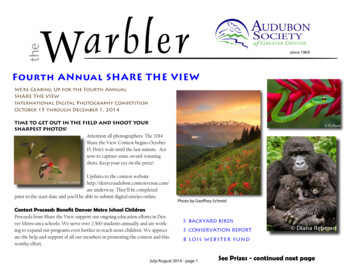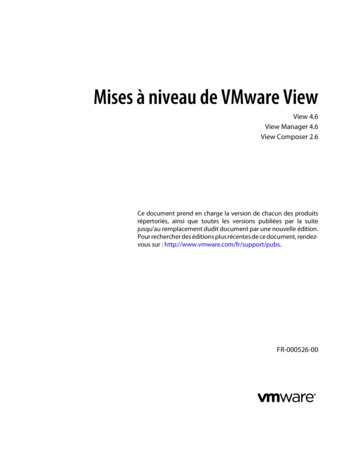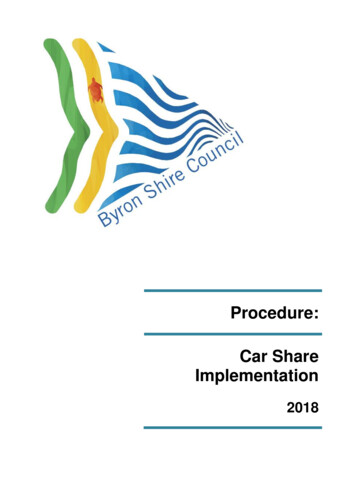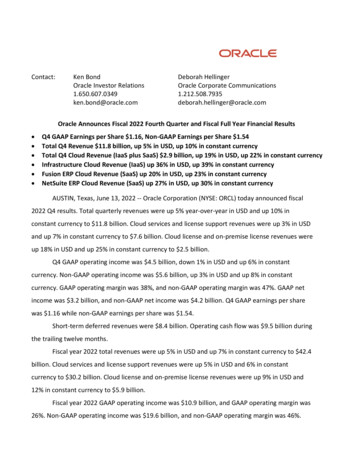
Transcription
theWsince 1969Fourth ANnual SHARE THE VIEWWe’re Gearing Up for the Fourth AnnualSHARE THE VIEWInternational Digital Photography CompetitionOctober 15 through December 1, 2014TIME TO GET OUT IN THE FIELD AND SHOOT YOURSHARPEST PHOTOS!Attention all photographers: The 2014Share the View Contest begins October15. Don’t wait until the last minute. Actnow to capture some award-winningshots. Keep your eye on the prize!Updates to the contest websitehttp://denveraudubon.contestvenue.com/are underway. They’ll be completedprior to the start date and you’ll be able to submit digital entries online.Photo by Geoffrey SchmidContest Proceeds Benefit Denver Metro School ChildrenProceeds from Share the View support our ongoing education efforts in Denver Metro area schools. We serve over 2,500 students annually and are working to expand our programs even further to reach more children. We appreciate the help and support of all our members in promoting the contest and thisworthy effort.5 Backyard Birds3 Conservation rEPORT8 L oi s W eb st er F un dJuly/August 2014 - page 1See Prizes - continued next page
Bird BandingShare the VIew (cont.)Ten cash prizes will be awarded:One Grand Prize of 1,000Four first place prizes of 250Five second place prizes of 100Entries will be accepted from October 15 through December 1, 2014There will be additional recognition for Colorado photographers, including anevening event at The Wildlife Experience museum in early 2015.Judging will take place in early December 2014Help Us Reach Our GoalFired Up And Ready To Go!Thanks to all of you for your support of last year’s competition. We are determined to make the 2014contest another hugesuccess. Please join us byentering your photos orby promoting the competition as often and in asmany places as you can!Our goal this year is to have over 2,000 entries. Our judges will balance emphasis on creativity and originality with technical skill. Here’s a rundown onthe 2014 contest.We Want You!We have many expert photographers in our group who are often tapped tomake presentations around the state showcasing pictures from their travels.We hope our memberphotographers will respond to our call andenter the Share theView Competition.How You CanHelpWoodpecker Woes and Other Wildlife -issues/This link will connect you to theNational Audubon Website and other helpful links to help you deal with commonquestions!Please help us spreadthe word by emailingfriends, family andcolleagues, posting onFacebook and Twitter, and making announcements at meetings or gatheringsof photographers and birders. We really appreciate your support!July/August 2014 - page 2Here is the website forfolks to report foxsightings as part of aresearch project:www.ifoundafox.org
Conservation Reportby Polly ReetzWhat Happened in the Legislative Session?Three ASGD members testified at the Senate Agriculture Committeehearing on HB 1333, asking that the bill state clearly what the money wouldgo for. After all, these are public funds and the public certainly has a right toknow how they would be used. We also pointed out the economic uncertainties involved – what if the Chatfield participants don’t pay the state back?Then the public has lost millions of dollars.The Colorado General Assembly ended its 2014 session at midnight onMay 7, having made no great achievements in the environmental field, but without passing any terrible bills either. Among the casualties (bills that died orwere killed) was a bill to assert State pre-eminenceon water rights on US Forest Service lands, whichwas probably unconstitutional since federal actionsDespite our statements, the Committeehave supremacy over state laws.passed the CWCB’s bill with full fundingA bill that would have promoted speculation infor the Chatfield subsidies. When the billwater use was voted down on the House floor: HBreached the Senate floor, Senator Andy Kerr,1320, which would allowed holders of conditionalsome of whose constituents live close to(not yet put to use) water rights to go 10 years beforeChatfield State Park, offered an amendment tothey had to show progress towards actually using thedelete the whole section dealing with Chatwater. It would have rewarded people for sitting onfield. Unfortunately it was voted down, 31 towater rights for which they no longer had a use and4. Sen. Kerr was joined by Sens. Linda Newallowed speculation with water that should probablyMountain Chickadee by Dick Vogelell, Matt Jones and Jessie Ulibarri in votingbe available to someone else (like a river, perhaps).for the deletion; we thank them for this courageous decision.The usual bills to keep the state from regulatWe got a small victory, a statement of legislative intent attached to the bill,ing industry activities in order to protect the public health, safety and welfarethat the funds would go for mitigation.were introduced, and died. Several bills requiring the federal government tocede ownership/management of most federal lands to the state also died, hapCombined with last year’s authorization of 62 million, the State ispily.now in hock to the tune of about 150 million for this project, despite thepromises by the water providers that “no taxpayer dollars will be spent onAn unusual development. ASGD took direct action on HB 1333, whichChatfield.” True, 88 million is a loan, but time, change in government, andauthorized spending by the Colorado Water Conservation Board for variousfailure of commitment could leave the State holding the bag on this very dewater projects. A section of the bill authorized the CWCB to loan almost 88structive project. And how ironic – public monies are being used to destroy amillion to 6 of the participants in the Chatfield Reallocation project, so theypremier public park.could “purchase storage space” in Chatfield Reservoir (the money would goto the US Army Corps of Engineers, which built and operates Chatfield Dam).For up-to-date information on Chatfield, visitHowever, we knew that the Corps was only charging a total of 16 million forwww.savechatfield.orgstorage – where would the other 71 million go? Turns out the CWCB is subsidizing these participants by loaning them money to pay for mitigation of the(Cont. nex t page)project.July/August 2014 - page 3
Conservation Report(cont.)Outside the Legislature:Falconry Regulations and a Wetlands SurveyEnjoy the Birds of Summer Both at Home and in the FieldLet Front Range Birding be your Guide!In May the Colorado Hawking Club petitioned the Colorado Parksand Wildlife Commission to change the falconry regulations and extendthe season for take of wild raptors for falconry. Currently the season startsJune 1 and ends on January 1 of the subsequent year; CHC wanted theseason to run from May 15 to February 15. ASGD pointed out that the current regulations were crafted through discussion by diverse stakeholders,considered impacts on breeding birds, and were the result of discussionand compromise. Some raptors, such as eagles and great horned owls, havealready started their courtship process in January; some species are stillraising young in May (and June). We suggested that if the Commissionersthink change is necessary they should re-convene the stakeholder meetings.Of note: one falconer stated at the May Commission meeting that since theholidays make December so busy, falconers should have time in January andFebruary to capture birds.Fortunately, the Commission at their May meeting rejected that part of thepetition that would have changed the dates.The City and County of Denver is in the second year of a wetlandsinventory and encourages people to submit suggestions about wetlands inDenver that should be included. Send such suggestions to Alan Polonsky,Dept. of Environmental Health, alan.polonsky@denvergov.orgAnd/or Kelly Uhing, City Naturalist, Kelly.uhing@denvergov.org.Join us!The 1st Saturdayeach month for afree bird walk to adifferent FRBChotspot eachmonth. We just loveto get out there andsee the birds!A Nature Centerfor You and Your Family!Premium wild bird seed sport optics feeders nest boxes books gifts10% off storewide purchasesplus FRBC will donate anadditional 5% to ASGD formentioning this ad10146 West San Juan Way unit 110Littleton, 80127Open 7 Days A WeekM-F 10-6 Sat 10-5 Sun 12-5Offer Expires: Aug 31st, 2014. May not becombined with any other offers. Optics not included.www.frontrangebirding.comNEW! TERRA ED Binoculars FromLightweight and CompactThe TERRA ED is both lightweight andextremely compact. You can be wellprepared for any adverse conditionswhen observing nature. With a sturdy,lightweight housing, the inner workingsare perfectly protected, ensuring thelong-term precision of the ED lens system.TERRA ED8x42&10x42Superior OpticsSCHOTT ED glass and German optical design provide exceptionallybright, sharp, vivid images in any light.S & S OPTIKA6579 South BroadwayLittleton, Colorado 80121Phone: 303-789-1089Since 1972July/August 2014 - page 4Sales (new &used),Store Hours:Tues-Fri 10 am - 6 pmSaturday 10 am - 5 pmToll Free:877-396-3352Maintenance & Repair
Backyard Birdsby Hugh KingeryBefore the copious spring birds, a note (not an email!) fromBill & Evelyn Steinkuhler in Arvada: “We had an exciting afternoon May3 when a hive of Italian honey bees (about 8,000 bees) decided to set up residency on a lower branch of our Austrian pine tree. We called a beekeeper whocame and vacuumed them up and took them to Palisade, Colorado, to pollinateblossoms on the fruit trees. Thissummer when we eat a delicious Colorado peach, we willknow our bees did their job!”BY Birds emails took11 pages; consequently, manytelescoped reports herein.The May 10-11 rain andsnowstorm dropped all kindsBee Hive by Bill Steinkuhlerof birds in our yards – andover the metro area, especiallyChatfield State Park. Observers rated the unprecedented fallout as once-in-a-lifetime. Chatfield had 100sof Lark Buntings, Chipping, Clay-colored, and Lark sparrows; we counted 86Western Kingbirds and 66 Mountain Bluebirds on roads in the park, and at themodel airplane field, 200-300 Lark Buntings, 100 Yellow-headed Blackbirds, and100 Brown-headed Cowbirds. A telegraphic summary of our yard-bird fallout:Buzz & Shirley Bowers, Castle Rock: “a pair of Yellow-headedBlackbirds on feeder; Hummingbirds sipping through snow-covered feeder.”Brad Smith, Castle Rock: “two Hermit Thrushes, Black-headed Grosbeaks, and Chipping Sparrows, one Western Tanager,.”Bill & Evelyn: “50 Chipping Sparrows spent a cold snowy day in ourbackyard eating seed under the bird feeders. Also our pretty Spotted Towheewho has been here off and on all winter.”Becky Campell, Arapahoe County: “Ovenbird this afternoon foraging under overgrown honeysuckle shrubs; one Spotted and two Green-tailedTowhees; 18 species including two male Bullocks Orioles, Chipping Sparrow,Cooper's Hawk, unidentified empid.”Steve Larson, Northglenn: “inundatedwith sparrows: many Chipping, Brewer's,Clay-colored, Lark, and Field.”Glenn & Jeane Hageman, Denver: amini fallout: Brewer's, Chipping, and Clay-colored,Lazuli Bunting, Green-tailed Towhee.Pam Zimmer, Green Mountain: “a smallflock of Western Bluebirds hung out for the evening, also two Hermit Thrushes, twoYellow-rumped Warblers, House Wren,Rose-breasted GrosbeakChipping Sparrows, Lazuli Bunting, and aby Dick VogelRose-breasted Grosbeak, also Black-chinned andBroad-tailed hummingbirds.Lin Williams, Highlands Ranch: “Hummingbird feeder out at 5:15; at5:30, our little guy came, and coming ever since. Saw another male a bit larger andfeistier. He checked out the feeder but showed little interest and took off.Our little guy looks in the window at us when he flies over; have a feeling he'sone of the youngsters from last year.”Randy Nelson, Parker: “We're comfortable inside, feeling sad for thecold hummers outside. All day we've seen one male and one female Broad-tailed,and one Black-chinnedpair, with chasing aroundthe feeders. In theseconditions, you wouldthink they might savetheir energy anddispense with feederguarding!”Black -Chinned Hummingbirds by Dick VogelJuly/August 2014- page 5(Cont. nex t page)
Backyard Birds( cont. )Kay Chambers, Larkspur: “In spite of the Mother's Day blizzard,our first Bullock's Oriole appeared. He is snarfing the half-orange and grapejelly we keep for him; three pairs of Broadtails; a challenge keeping the hummingbird feeder ice-free. Lots of Spotted Towhees, House Finches, Redwinged Blackbirds, Scrub and Steller’s Jays, White-breasted Nuthatches, andjuncos - and one Downy Woodpecker.”Debbie Trujillo, Elbert County: “Two Bullock's Orioles, Downy andHairy Woodpeckers coming to tree nuts. A HarrisSparrow, both kinds of towhees and White-CrownedSparrows eating sunflowerchips off the ground. Aflock of Lark Sparrowspicking around rocks inthe driveway. Red-WingedBlackbirds, grackles, HouseWhite-Crowned Sparrow by Dick VogelFinches and Black-headedGrosbeaks. Robins and Mourning Doves nesting trying to keep their eggswarm.”Karen Metz, Franktown: “Ovenbird under the deck among dozens of ChippingSparrows and Dark-eyed/Gray-headedJuncos. Lesser Goldfinches and Blackheaded Grosbeaks. Hummers include onemale and two female Black-chinned, twomale and 3 female Broad-tailed.”RaritiesDebbie Trujillo, May 8-14: Brown Thrasher (second year).Kevin Corwin, Centennial, May 8: a male Indigo Bunting alongwith a Lesser Goldfinch.Glenn & Jeane Hageman,Denver, May 15: White-winged Dove.Pam Zimmer, May 16 sentpictures: “This little yellow bird appeared for a very brief time, I know thepictures are terrible, maybe anOrange-crowned Warbler?” Good ID.Bill Eden, Denver, May 17:“MacGillivray's Warbler in my waterfeature on and off for an hour.”Bill & Suzanne Wuerthele,Orange-Crowned Warbler courtesy Wikipediaeast Denver, May 17: “about 5:00 a.m.,a very surprising sound for urban Denver – the unmistakable call of the Common Poorwill. It called for 2-3 minutes but stopped before we got out to look forit. Based on the volume of the call, it was quite close, but we couldn’t find thesilent bird. At about 8:45 p.m., it called again. Based on volume, probably half ablock away. Then a second bird began calling – quite close. Suzanne spotted itsitting on a neighbor’s driveway. Shortly it flew off. The two birds continued tocall off-and-on, for about a half hour. Definitely a new yard bird for us (or, a new“from-the-yard-bird).”RaptorsDark-Eyed Junco by Dick VogelLinda Broeren, Aurora, Apr. 9: Two Mountain Chickadees, one hadvery thin white eyebrow, the other, thicker.” The thin thin-eyebrowed birdprobably a hybrid with Black-capped (per Duane Nelson).Kelley & Anne McCready, Lakewood, Mar. 20: “We live a blockfrom the Bear Creek Greenbelt and walk there once a week. On Feb. 14 and today, we saw a Northern Shrike in the same area. The shrike was flying, perching,and hunting in a grassland”July/August 2014 - page 6(Cont. next page)
Backyard Birds ( cont. )Lynn Baumeister, Mar. 16: “Springtime Tree-Topper. Our first kestrelsighting. Typically a male perches on this same tree overlooking our nest boxesand eventually brings a mate. It's humorous to watch him try to ‘sell’ a nest boxto her. He swoops down to the box and calls to her, frequently going in and outof the box.”Kevin Corwin, Mar. 30: “A lone Turkey Vulture was floating on thebreezes over the intersection of Hampden and Santa Fe on the western edge ofdowntown Englewood.”Char & Tom Gottlieb, Arvada, Mar. 22: “we have Red-tailed Hawksnesting in our willows - first time. Last year the nest was used by Cooper’shawks, also a first for us.”Randy Nelson, Parker, Mar. 23: “Last evening, a very large hawk roosted in the pine tree behind our yard. This morning a commotion started around the shadowyform that sunlight revealed as probably first-yearRed-tailed Hawk. First a flicker zoomed over itafter leaving the suet cake, then six crows weresuddenly careening loudly around the mostly unimpressed Buteo. Finally, the resident Cooper'sthat nests every year up the greenbelt perched ina nearby cottonwood and periodically ran sortiesright at the red-tailed intruder. After about fouror five very close calls, the much larger hawk gotthe message and went flying out of the pine overthe nearby rooftops with the Cooper's in closepursuit.”Sharp-Shinned Hawk by Dick VogelSharon Hines, Franktown, Apr.3: While I was eating breakfast, two Sharpshinned Hawks in tandem strafed the bushes behind the feeders. Both missed,swooped up, and both came back together in a second attack. Blue Jays screaming bloody murder! As far as I could tell, both hawks came up empty taloned.”Fran Shepperdson, Kiowa, Apr. 29: “Coming south on Road 21, I hadto stop for a young vulture (i.e., stupid) eating a squirrel remains in the center ofthe road. He watched me for half a minute and then flew to a fence when a truckcame by on the other side.”Yard birdsPeggy Wait, near Chatfield, May 5: “Two Swainson's Hawks flirtingwith a nest nearby but the cottonwood with the nest died due to lack of waterin the Highline Canal. The good news is Denver Water started running waterlast week but it is too late for many of the large old cottonwoods that line thecanal. Within eyesight of the would-be Swainson's nest is a Red-tailed Hawknest, just inside the Chatfield State Park Boundary. The female has been on the nest for justover two weeks, about the time the Swainson'sshowed up.”Other stuffLisa Crispin, Douglas County,May 3: “Last weekend, a set of finches got intoour tack room, and refused to go out either theopen door or another opening where I couldreach netting (that someone must have put upat some point to keep birds out) and move itout of their way. We left doors open overRed-Tailed Hawk by Dick Vogelnight, but in the morning, still in an apparently panicked state, they wanted to escape through the chicken wire stretchedacross the tallest wall. Finally my husband got out the tall ladder and made ahole in the chicken wire; they promptly exited and thankfully have not comeback.”Your contributions write this column. I’d like to hear from morefolks in urban and suburban Denver.) Send a note or post card toP.O. Box 584, Franktown 80116, or Email me: ouzels8@aol.com.July/August 2014 - page 7
Lois Webster FundBlack Swifts, Rock Wrens, Pika and More Why do female rock wrens pave the entrances to their nests? Do black swiftsreally prefer flying ants for dinner? Where do incubating mountain plovers forage when they leave their nests?These were among the questions posed in the presentations by the 2013 LoisWebster Fund grantees at the LWF annual meeting on April 16 at ColoradoCraft Breweries in lower downtown Denver. The five presentations were rated“absolutely terrific” by ASGD members Hugh andUrling Kingery: “Each one had its own fascinations!”Nat Warning, the rock wren researcher, put forward several hypotheses about the nest pavementand found some evidence to support at least one:the paving stones at the nests help keep themdrier. Kim Potter, an employee of the US ForestService, had compiled descriptions of the type,size and numbers of prey items taken by blackswifts in Colorado; the data indicate that blackswifts prefer leafhoppers and mayflies, by far,though they will eat flying ants too.Amy Masching from the Denver Zoo reported the activities ofthe Front Range Pika Project’s 40 volunteers in the field last summer,collecting data to evaluate factors that could drive changes in pika distribution. Colin Woolley of RMBO/ CU Denver described the resultsof capturing, banding and attaching transmitters to adult mountainplover to follow their movements on the breeding ground and in migration. We’re still learning about Lois Webster’s favorite bird!Black Swift photo by Todd PatrickA very timely project conducted by Sara Bombaci, CSU, looked at how habitat manipulationin areas affected by oil and gas development might affect songbirds and smallmammal populations. The chaining, crushing and removal of pinyon/juniper treecover is designed primarily to benefit big game (mule deer), but if some treesare left standing, she found, bird species diversity is much higher.July/August 2014 - page 8The Lois Webster Fund continues tosupport research and education fornongame wildlife in Colorado, and theprojects have been fascinating. Wehope more ASGD members will join usfor these annual talks.
Educate Generations - Protect Birds and Habitats into the FutureInclude ASGD in Your Will and Other Gift Planning OptionsThe Audubon Society of Greater Denver offers an opportunity for youto make a gift or bequest to leave a legacy and a lasting impact. The goalof planned giving is to help you plan your estate and charitable giving ina way that benefits you, your family and ASGD. We invite friends whoshare a commitment to educating all ages about birds, other wildlife, andhabitats to consider making a personal investment in the future of ourprograms. There are several ways you can make these planned gifts tocharity and enjoy tax and income benefits: Specific, Residuary and Contingent BequestsRetirement Accounts and Pension PlansInsuranceSecuritiesCharitable Remainder Trust (CRT)Charitable Gift Annuity (CGA)Please Let Us KnowWe often receive bequests from people whom we have never had theopportunity to thank. If you include Audubon Society of Greater Denver inyour estate plans, please let us know. We value the opportunity to express ourgratitude in person to let you know that your gift is greatly appreciated nowand for future generations of people and birds to come. Those people who havenotified us of their intention to make a bequest to the Audubon Society ofGreater Denver are invited to our Legacy Circle. Legacy Circle special eventsand activities highlighting the work we accomplish together will keep youconnected to the “legacy” that you have planned for us.Legal Designation: If you wish to name Audubon Society of GreaterDenver in your will or estate plan, we should be legally designatedas: “Audubon Society of Greater Denver, a nonprofit organization(Tax ID #23-7063701), with its principal business headquarters address of9308 S. Wadsworth Blvd, Littleton, CO 80128.”Date of Incorporation: September 30, 1969Please consult with your financial planner and attorney to assure youreceive the best financial advantages and that your intentions arecarried out fully.We would be glad to discuss any planned giving option with you –in confidence and without obligation. For more information, please call303-973-9530 or e-mail Karl Brummert, Executive Director,at kbrummert@denveraudubon.orgJuly/August 2014 - page 9Photo by Dick Vogel
Volunteers, Donors, New Members and OfficersNew FriendsDirect DonorsJane DerrickKaren HagerMaggie BrahmMargo ConstableMollie RuePeter & June BosmanRudy SanchezRuth WagnerVolunteersAudubon Center Volunteers/SchoolProgramsCassandra Ali, Dotty Biggs, Sheila Burns, LindaCovnot, Angela Grun, Marsha Heron, LindaLenway, Melanie Lewis, Phil Lyon, Barbara Masoner, Jeanne McCune, Alex O’Connell, MicheleOstrander, Susan Perry, Yvonne Salfinger, GingerSawatzki, Jack Sawatzki, Ali Warren,Wendy Wibbens, Katherine WolfsonOffice HelpDick Anderson, Jeanne McCune, MicheleOstrander, Carolyn Roark, Bob StockerWebsite/MediaDick AndersonMary UrbanField Trips & ClassesKaren Bickett, Kevin Corwin, Bill Eden,Martha Eubanks, Mackenzie Goldthwait,Celia Greenman, Hugh Kingery, UrlingKingery, Lois Levinson, Janet Shin, CindyValentine, Wendy WibbensGardening/MaintenanceFred Griest, Robert Stone, Michael KiessigStaffTo contact usinfo@denveraudubon.orgThanks to all committees,board members and AudubonMaster Birders for volunteeringtheir time.Karl BrummertExecutive DirectorEmily HertzSchool Programs CoordinatorKristine HelsperAudubon Center CoordinatorYour volunteer hours are veryimportant to us!Your volunteer hours are very important to us aswe use them to raise money through grants andthe SCFD. Please record your hours on Volgisticsor email Kristine Helsper your completed hours assoon as possible. Thanks!Leona BergerPeter & June BosmanLeslie BrownDeborah A. CarstensenDoris V. DavisJeff & Kathleen M.DunningJohn & Barbara EcklerCarol ElfringByron & Chris GibbonsLeon & Patricia JohnsonWilliam R. KillamDiane KraftMemory LamfersPhil Lyon9308 South Wadsworth Blvd.Littleton, CO 80128303.973.9530Fax: 303.973.1038www.denveraudubon.orgRhonda ShankOffice ManagerMary UrbanNewsletter Design/LayoutJuly/August 2014 - page 10Suzanne MayesGeorge I. OguraMillie TurnerEmma WatsonCircle DonorsFred Griest, Betty RobertsonDonationsPolleke Siraa donated twoboxes of bird books.Officers & DirectorsCarol DeStefanis, PresidentArlene Raskin, 1st Vice PresidentAnn Bonnell, 2nd Vice PresidentTreasurer - VacantDoris Cruze, Acting SecretaryDoug KibbeCarl NorbeckMichele OstranderDan MorrisKristin SalamackThe Warbler is published bi-monthly by theAudubon Society of Greater Denver (ASGD)Produced by M. Urban 2014ISBN 1531-2283 Vol. 48 Number 4
Denver that should be included. Send such suggestions to Alan Polonsky, Dept. of Environmental Health, alan.polonsky@denvergov.org And/or Kelly Uhing, City Naturalist, Kelly.uhing@denvergov.org. Conservation Report (cont.) July/August 2014 - page 4 Sales (new & used), Maintenance & Repair Phone: 3 03 -7 891 Toll Free:877-396-3352











